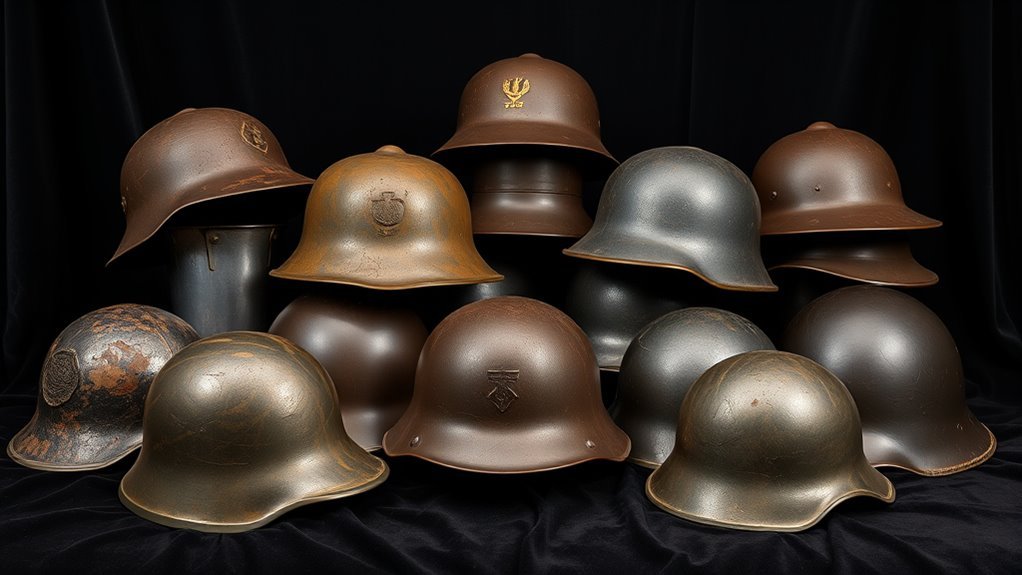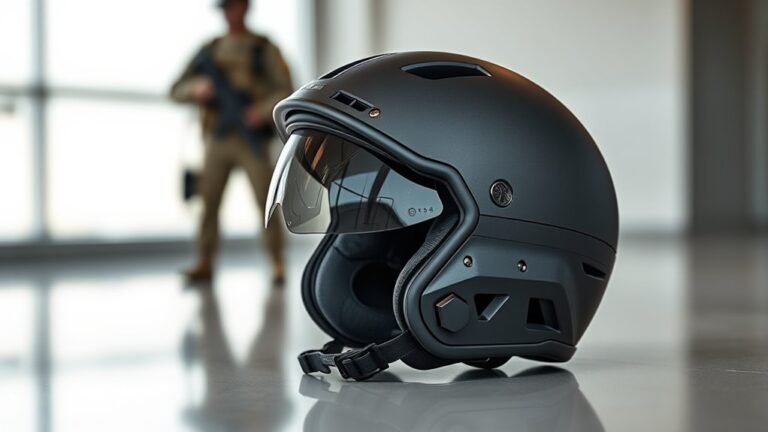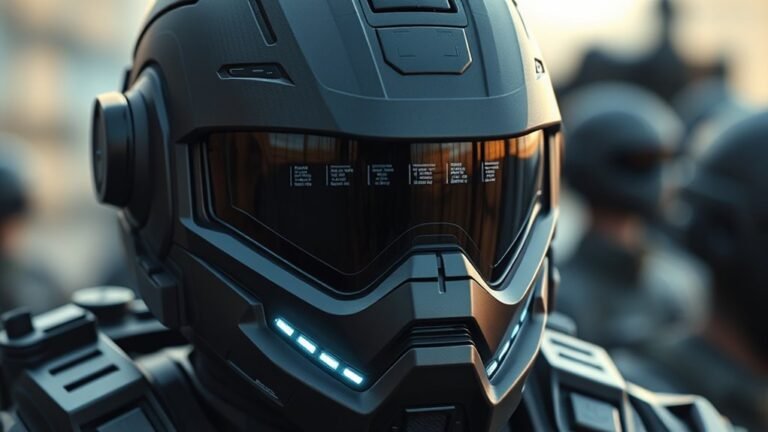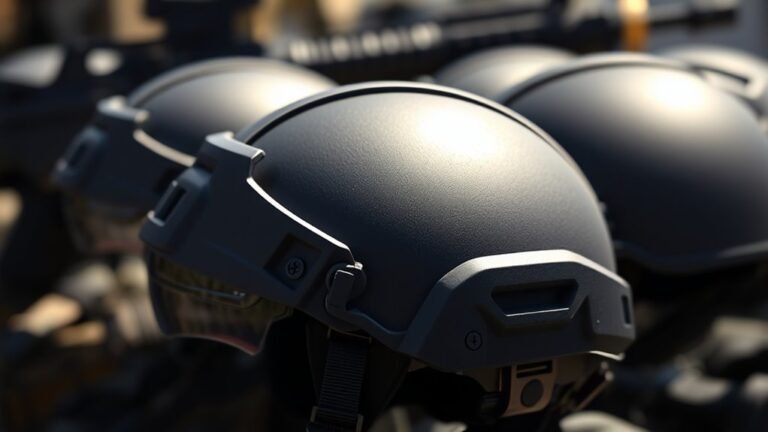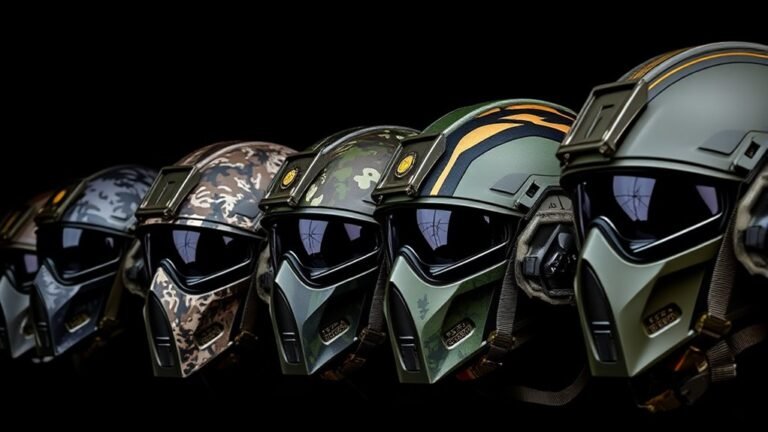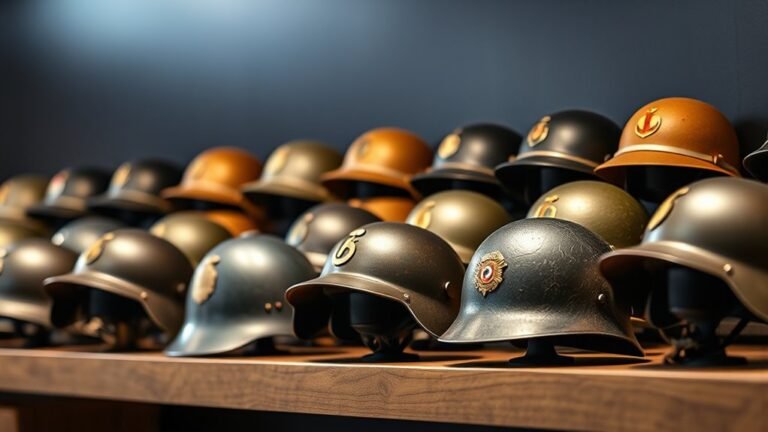Evolution of World War Helmets
The evolution of World War helmets represents a critical advancement in soldier safety and performance. Initially designed for protection, helmets transformed through necessity during conflicts, particularly with innovations like the Brodie helmet in WWI, featuring lightweight steel and improved shapes. Material advancements such as ceramic composites enhanced ballistic protection while reducing fatigue. Military conflicts have continuously influenced helmet design, integrating features for better functionality. Exploring this journey reveals how each change shaped the experience of soldiers on the battlefield.
The Origins of Helmet Design in Ancient Warfare
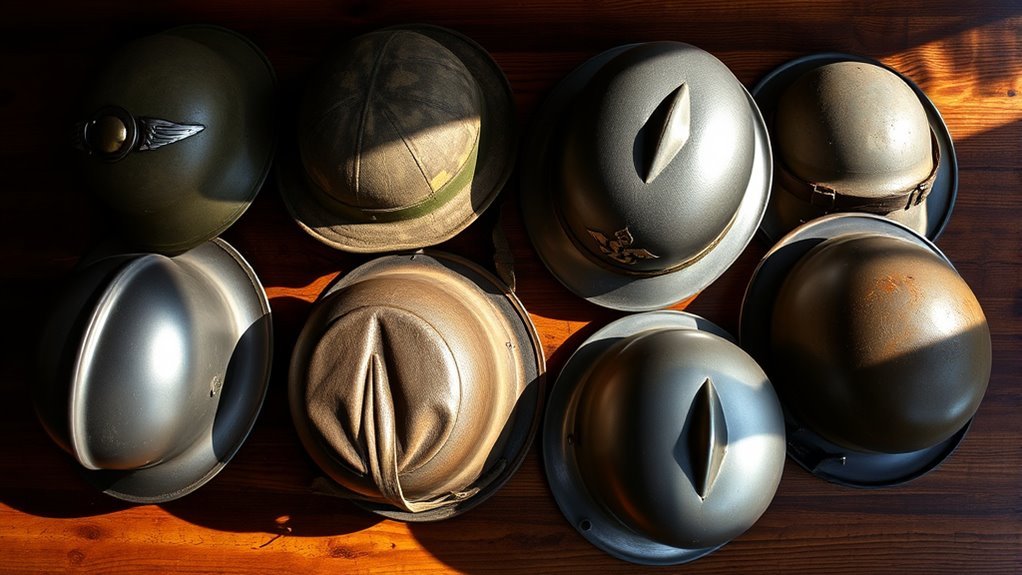
Although helmets have a long history in military design, their origins can be traced back to ancient warfare, where they served both practical and symbolic purposes. Early helmets were crafted from ancient materials like bronze and leather, providing essential protection for warriors in battle. These designs evolved alongside combat strategies, as different cultures adapted their helmets to address unique threats. For instance, the Greeks and Romans employed helmets that not only shielded the head but also embodied their identity and status on the battlefield. By examining these early innovations, you can appreciate how ancient materials and combat strategies shaped helmet design, laying the groundwork for future advancements. Ultimately, these early helmets represented a fusion of functionality and symbolism, vital for the warriors’ quest for freedom and survival.
The Impact of World War I on Helmet Development
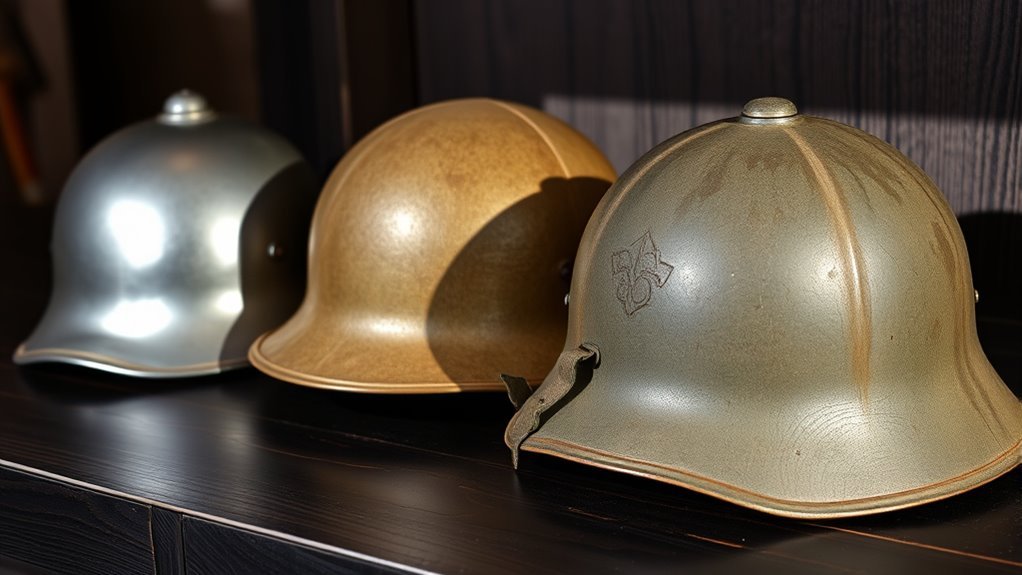
World War I greatly influenced helmet design, pushing innovations that prioritized protection against shrapnel and bullets. You’ll notice that advancements in materials and manufacturing processes led to lighter and more durable helmets, such as the iconic steel designs introduced during the conflict. These changes not only enhanced soldier safety but also set new standards for military headgear in future wars.
Design Innovations in Helmets
As the horrors of trench warfare unfolded during World War I, the urgent need for effective head protection led to significant design innovations in military helmets. Historical comparisons reveal that earlier models lacked the necessary resilience and comfort. The introduction of the Brodie helmet, for instance, showcased ergonomic considerations, prioritizing fit and weight distribution to enhance soldier mobility. Innovations such as a sloped design helped deflect shrapnel, while the addition of a liner improved comfort and reduced impact forces. These advancements not only protected soldiers but also set a precedent for future helmet designs, emphasizing the balance between functionality and user comfort. Ultimately, World War I catalyzed a transformation in helmet design, reflecting a deeper understanding of the demands of modern warfare.
Materials and Manufacturing Advances
While the urgent demands of trench warfare during World War I spurred innovations in helmet design, it also catalyzed significant advancements in materials and manufacturing processes. The introduction of lightweight materials, such as steel and later, ceramic composites, revolutionized helmet production, enhancing soldier protection without compromising mobility.
| Material Type | Advantages | Applications |
|---|---|---|
| Steel | Durable, cost-effective | Early war helmets |
| Lightweight Alloys | Reduced weight, strong | Improved helmets post-WWI |
| Ceramic Composites | High impact resistance, lightweight | Modern military helmets |
These advancements not only improved safety but also encouraged further exploration into materials science, paving the way for contemporary helmet designs that balance protection and comfort, ensuring freedom of movement in combat.
The Introduction of the Brodie Helmet
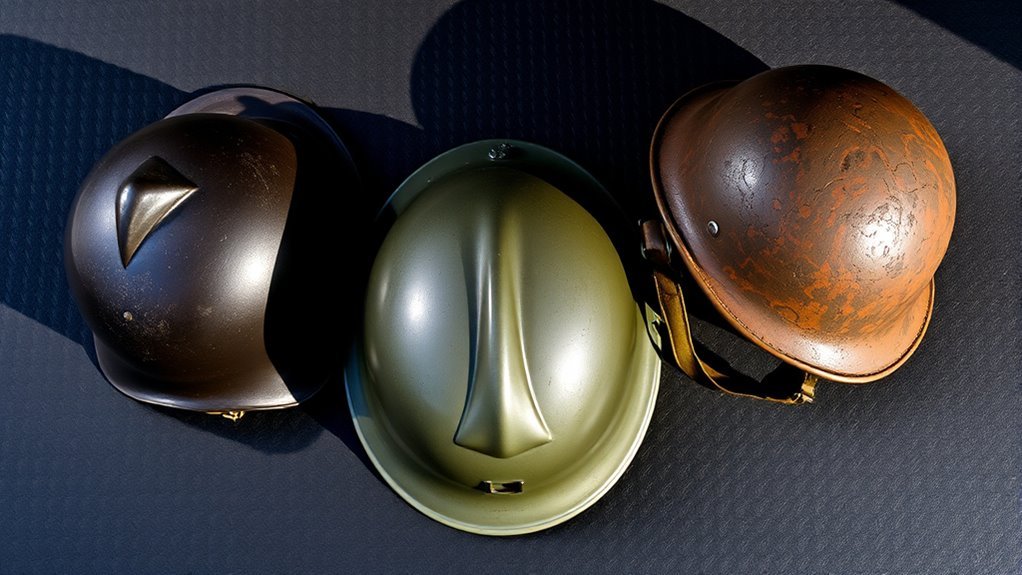
The introduction of the Brodie helmet marked a significant shift in military headgear during the First World War, primarily due to its innovative design that prioritized both protection and functionality. Developed in 1915 by John Brodie, this helmet featured a distinctive bowl shape and a wide brim, effectively deflecting shrapnel and debris. The Brodie helmet’s history reflects a response to the grim realities of trench warfare, showcasing a blend of practicality and combat readiness. Its lightweight steel construction made it easier for soldiers to wear for extended periods, while the adjustable chin strap guaranteed a secure fit. Ultimately, the Brodie helmet set a new standard in military protection, influencing countless designs that followed and emphasizing the need for adaptive gear in warfare.
Innovations in Materials: From Steel to Composite
As you consider the evolution of helmets, it’s essential to recognize the limitations that steel presented regarding weight and comfort for soldiers. Advancements in composite materials have greatly transformed helmet design, enhancing protection while reducing bulk. This shift not only improved mobility but also had a profound impact on overall soldier safety in combat scenarios.
Steel Helmet Limitations
Although steel helmets were revolutionary in their time, they come with significant limitations that prompted military innovators to seek alternative materials. The weight distribution of steel can lead to discomfort factors during prolonged wear, affecting soldiers’ performance. Visibility issues arise as heavier designs restrict peripheral vision, impacting situational awareness. Additionally, steel helmets often result in hearing limitations, as the solid material muffles sound, distancing soldiers from their environment. Manufacturing costs are another concern, as producing steel helmets can be expensive compared to lighter materials. Historical comparisons highlight these drawbacks, revealing psychological effects where soldiers felt encumbered by bulky designs. Ultimately, design aesthetics may not align with modern military needs, emphasizing the need for innovation beyond traditional steel construction.
Advancements in Composite Materials
While traditional steel helmets served their purpose during earlier conflicts, advancements in composite materials have transformed the design and functionality of modern combat headgear. Today’s helmets utilize lightweight materials, such as aramid fibers and polycarbonate, that considerably reduce weight without compromising protective capabilities. This shift towards composite durability not only enhances comfort for soldiers but also allows for better mobility in fast-paced environments. Furthermore, the integration of advanced composites enables the incorporation of additional features, such as communication systems and improved ventilation, without adding unnecessary bulk. As military technology continues to evolve, the focus on composite materials illustrates a commitment to enhancing soldier performance while ensuring their protection, reflecting a broader pursuit of innovation and freedom on the battlefield.
Impact on Soldier Safety
The shift from steel to composite materials in military helmets greatly enhances soldier safety, addressing both protection and comfort on the battlefield. Composite helmets provide significant improvements in helmet effectiveness by offering greater impact resistance while being lighter in weight. This reduction in weight not only decreases fatigue but also allows for greater mobility, essential during combat operations. Enhanced comfort leads to improved soldier morale, as personnel feel more secure and agile. Additionally, composite materials can be designed to incorporate advanced technologies, such as communication systems and night vision compatibility, further elevating operational efficacy. By prioritizing both safety and functionality, these innovations reflect a commitment to the well-being of soldiers in the field, ultimately contributing to mission success and personal resilience.
The Evolution of Helmet Shapes and Designs
As military needs evolved, so too did helmet shapes and designs, reflecting both advancements in technology and changes in combat tactics. Historical influences played a significant role in shaping these designs, as each era adopted features that suited the prevailing warfare strategies. For instance, the shift from the heavy, rounded helmets of World War I to the sleeker, more aerodynamic shapes of World War II showcased an adaptation to increased mobility and firepower. Cultural variations also contributed to helmet designs, with different nations incorporating unique aesthetics and materials influenced by their own military traditions. This evolution illustrates a constant pursuit of balance between protection and functionality, ensuring that soldiers can effectively respond to the complexities of modern warfare while honoring their heritage.
The Role of Helmets in World War II
In World War II, helmet design underwent significant innovations, incorporating advanced materials that enhanced durability and protection. These helmets were essential in safeguarding soldiers against shrapnel and other battlefield hazards, ultimately influencing survival rates. Furthermore, the psychological impact of wearing a helmet cannot be overlooked, as it provided a sense of security and identity amidst the chaos of war.
Design Innovations and Materials
Although many factors contributed to the effectiveness of World War II soldiers, helmet design and materials played an essential role in enhancing soldier protection and comfort. Innovations such as the introduction of lightweight steel and composite materials considerably improved durability while reducing fatigue. The iconic shape and structure of helmets were influenced by historical designs, adapting to the needs of modern warfare. Helmet aesthetics also began to reflect national identity, with distinctive markings and colors signifying different units. These changes not only aimed to provide better functionality but also fostered a sense of belonging among soldiers. As you analyze these developments, you’ll see how design and materials intertwine with broader historical influences, shaping the war experience and soldier effectiveness.
Protection Against Shrapnel
While the advancements in helmet design during World War II primarily focused on enhancing protection against gunfire, their fundamental role in safeguarding soldiers from shrapnel cannot be overlooked. Shrapnel was a pervasive threat on the battlefield, flying debris from explosions causing severe injuries. Helmets incorporated improved materials and shapes aimed at maximizing shrapnel protection, which markedly impacted helmet effectiveness. The design featured a rounded profile, allowing for better deflection of incoming fragments. Soldiers found that these helmets could absorb and redirect energy, reducing the severity of injuries. Though not infallible, the helmets provided a critical layer of defense, contributing to the overall survival and resilience of troops in combat. Therefore, understanding shrapnel protection remains essential in appreciating these historical advancements.
Psychological Impact on Soldiers
When soldiers donned their helmets during World War II, it wasn’t just a matter of physical protection; these helmets also played a crucial role in shaping their psychological state. The presence of a helmet contributed greatly to soldier morale and psychological resilience. Here are some key aspects:
- Identity and Camaraderie: Helmets fostered a sense of belonging among troops.
- Fear Reduction: Wearing a helmet helped mitigate fear, providing a sense of security.
- Focus on Duty: The helmet symbolized a soldier’s commitment, enhancing focus on their mission.
- Mental Shielding: It served as a psychological barrier against the chaos of war, promoting mental fortitude.
Ultimately, these factors combined to bolster soldiers’ morale, proving that helmets were more than mere equipment; they were essential to maintaining psychological strength in battle.
Advancements in Ballistic Protection
As military conflict evolved, so too did the need for helmets that could withstand increasingly sophisticated ballistic threats. Modern advancements have introduced innovative ballistic materials like Kevlar and Twaron, which greatly enhance protection without adding excessive weight. These materials meet rigorous protective standards, ensuring that helmets can effectively shield soldiers from shrapnel and high-velocity projectiles. The integration of multi-layered constructions allows for improved energy dispersion, reducing the risk of traumatic brain injuries. Additionally, advances in design have led to better fit and comfort, enabling enhanced mobility in combat situations. As you consider the implications of these developments, it’s clear that the evolution of ballistic protection in helmets not only saves lives but also empowers soldiers to operate with greater confidence on the battlefield.
The Integration of Technology in Modern Helmets
With the rapid advancement of technology, modern helmets have evolved into sophisticated pieces of equipment that go beyond mere head protection. These innovations enhance user experience and safety, integrating various features:
- Smart Technology: Helmets now include sensors that monitor impact and provide real-time data.
- Augmented Reality: Users can access critical information directly in their line of sight, improving situational awareness.
- Communication Systems: Enhanced connectivity allows seamless interaction, essential in team operations.
- Lightweight Designs: Modern materials reduce weight without compromising safety, enhancing comfort during extended use.
Additionally, adaptive features, modular components, and user customization options offer tailored solutions, ensuring helmets meet diverse operational needs, promoting both freedom and effectiveness in the field.
The Influence of Military Conflicts on Helmet Features
Throughout history, military conflicts have considerably shaped the design and functionality of helmets, reflecting the evolving needs of soldiers on the battlefield. Tactical adaptations emerged as warfare technologies advanced, requiring helmets to offer improved protection against new threats. For instance, during World War I, the introduction of machine guns necessitated the redesign of helmets for better ballistic resistance. Cultural influences also played a role, as various nations incorporated unique artistic elements into their helmet designs, showcasing national identity while serving practical purposes. As conflicts progressed, the emphasis shifted towards lightweight materials, enhanced comfort, and integration of communication systems. These adaptations not only safeguarded lives but also symbolized the resilience and evolution of military craftsmanship in response to the demands of warfare.
Future Trends in Helmet Design and Functionality
The evolution of military helmets is set to continue, driven by advancements in technology and an increasing focus on soldier well-being. Future helmet designs will likely incorporate several innovative features aimed at enhancing functionality and safety:
- Smart Helmets: Integrating sensors for real-time health monitoring and environmental awareness.
- Augmented Reality: Providing critical information, such as navigation and threat detection, directly in the soldier’s line of sight.
- Lightweight Materials: Utilizing advanced composites to reduce fatigue while maintaining superior protection.
- Modular Designs: Allowing for customization based on mission requirements, ensuring versatility in various combat scenarios.
These trends highlight a shift towards helmets that not only protect but also empower soldiers, enhancing their operational effectiveness and overall experience on the battlefield.
Frequently Asked Questions
How Were Helmets Used in Non-Military Contexts Throughout History?
Throughout history, helmets served various roles beyond military applications. You’d find historical headgear used in ceremonial contexts, symbolizing status or authority. For instance, ancient cultures adorned helmets for rituals or as part of royal regalia, representing power and protection. In sports, helmets evolved to enhance safety while maintaining a connection to their protective roots. These non-military uses illustrate how headgear’s significance extends into cultural, social, and ceremonial domains, highlighting humanity’s desire for both protection and expression.
What Are the Most Famous Helmet Designs From Different Cultures?
When you think of helmets, they’re like crowns of valor, each telling a story of its culture. The Roman Centurion helmet, with its distinctive crest, symbolizes authority. The Samurai Kabuto, intricately designed, reflects honor and craftsmanship. Viking helmets, often horned, evoke a fierce and adventurous spirit. Finally, the Greek Corinthian showcases a sleek design, emphasizing both protection and artistry. Each helmet is a representation of the values and identities of its time, deserving of appreciation.
Are There Any Civilian Applications for Military Helmet Technology?
Yes, there are significant civilian applications for military helmet technology. Innovations in design and materials enhance civilian safety in various fields, such as construction and sports. These advanced helmets can absorb impacts better, provide improved visibility, and reduce overall weight, making them more comfortable for everyday use. By adapting military-grade features for civilian purposes, you can benefit from enhanced protection while engaging in activities that require head safety, ensuring you stay secure in different environments.
How Do Cultural Perceptions of Helmets Vary Globally?
Cultural perceptions of helmets vary widely; for instance, in Japan, the kabuto helmet symbolizes honor and bravery, while in the West, helmets are often seen as mere safety gear. Notably, 30% of motorcyclists in some countries wear helmets for fashion rather than protection. This helmet fashion reflects cultural symbolism, where style can sometimes overshadow functionality. Understanding these differences reveals how deeply culture influences our views on protective gear and its significance in daily life.
What Role Do Helmets Play in Modern Sports Safety?
Helmets play an essential role in modern sports safety by minimizing head injuries. You’ll find that helmet regulations vary by sport, often mandating impact testing to guarantee they meet safety standards. These tests assess how well helmets absorb and distribute force during collisions. By adhering to these regulations, athletes can greatly reduce their risk of concussions and other serious injuries, allowing for a safer environment while still enjoying the thrill of competition.
